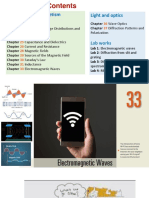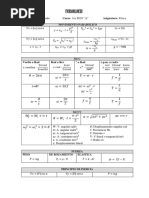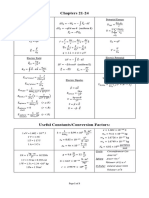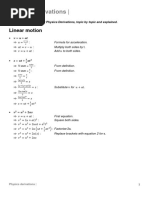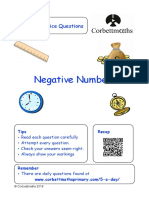lecture13-ch28-1
Uploaded by
wpltommylecture13-ch28-1
Uploaded by
wpltommyCH 28 SOURCES OF MAGNETIC FIELD I
Intended Learning Outcomes – after this lecture you will learn:
1. Magnetic field due to a moving charge
2. Magnetic field due to a current, the Biot-Savart law
3. To define ampere in terms of the force between two long current-carrying wires
4. Magnetic field due to a current-carrying coil
Textbook Reference: 28.1 – 28.5
Demonstration:
An electromagnet – current produces magnetic field
Magnetic Field due to a Moving Charge
Instantaneous magnetic field due to the moving charge
is
�⃗ × 𝒓𝒓� 𝜇𝜇0 𝑞𝑞𝒗𝒗
𝜇𝜇0 𝑞𝑞𝒗𝒗 �⃗ × �⃗
𝒓𝒓 𝜇𝜇0 |𝑞𝑞|𝑣𝑣
��⃗
𝑩𝑩 = = or 𝐵𝐵 = sin 𝜙𝜙
4𝜋𝜋 𝑟𝑟 2 4𝜋𝜋 𝑟𝑟 3 4𝜋𝜋 𝑟𝑟 2
Inverse square law! Like 𝑬𝑬 �⃗ due to a point charge
Ignore effect of the acceleration of the charge,
which will cause radiation
𝜇𝜇0 is a proportionality constant called the vacuum permeability, a measure of how easy/difficult
to create a magnetic field in vacuum, c.f. 𝜖𝜖0 is the vacuum permittivity
SI unit: T⋅m2 ⁄C⋅ms −1 = T⋅m/A
Value of 𝜇𝜇0 is chosen to be exactly 4𝜋𝜋 × 10−7 T⋅m/A, not experimentally determined, c.f. 𝜖𝜖0
PHYS1114 Lecture 13 Sources of Magnetic Field I P. 1
Magnetic Field due to a Current Element
Total charge in the current element 𝑑𝑑𝒍𝒍⃗
𝑑𝑑𝑑𝑑 = 𝑛𝑛𝑛𝑛(𝐴𝐴 𝑑𝑑𝑑𝑑)
𝜇𝜇0 |𝑑𝑑𝑑𝑑|𝑣𝑣𝑑𝑑 𝜇𝜇0 𝑛𝑛𝑛𝑛𝑣𝑣𝑑𝑑 𝐴𝐴 𝑑𝑑𝑑𝑑
𝑑𝑑𝑑𝑑 = 2
sin 𝜙𝜙 = sin 𝜙𝜙
4𝜋𝜋 𝑟𝑟 4𝜋𝜋 𝑟𝑟 2
Since (𝑛𝑛𝑛𝑛𝑣𝑣𝑑𝑑 )𝐴𝐴 = 𝐽𝐽𝐽𝐽 = 𝐼𝐼
𝜇𝜇0 𝐼𝐼 𝑑𝑑𝑑𝑑
⇒ 𝑑𝑑𝑑𝑑 = sin 𝜙𝜙
4𝜋𝜋 𝑟𝑟 2
𝜇𝜇0 𝐼𝐼 𝑑𝑑𝒍𝒍⃗ × 𝒓𝒓� 𝜇𝜇0 𝐼𝐼 𝑑𝑑𝒍𝒍⃗ × 𝒓𝒓
�⃗
��⃗ =
or 𝑑𝑑𝑩𝑩 =
4𝜋𝜋 𝑟𝑟 2 4𝜋𝜋 𝑟𝑟 3
This is called the Biot-Savart law.
To sum up the total magnetic field
𝜇𝜇0 𝐼𝐼 𝑑𝑑𝒍𝒍⃗ × 𝒓𝒓� 𝜇𝜇0 𝐼𝐼 𝑑𝑑𝒍𝒍⃗ × 𝒓𝒓
�⃗
��⃗
𝑩𝑩 = � = �
4𝜋𝜋 𝑟𝑟 2 4𝜋𝜋 𝑟𝑟 3
The Biot-Savart law is fundamental (i.e., cannot be derived), just like the Newton’s law of
gravity in gravitation, and the Coulomb’s law in electrostatics.
Question: Isn’t the Biot-Savart law derived from the formula of a single moving charge?
Answer: Given the Biot-Savart law, we can derive the previous formula of the magnetic field due
to a moving charge: if the current is due to a single charge 𝑞𝑞, the current element traced out in
time Δ𝑡𝑡 is 𝑑𝑑𝑑𝑑 = 𝑣𝑣Δ𝑡𝑡, i.e., 𝐼𝐼 𝑑𝑑𝑑𝑑 = (𝑞𝑞 ⁄Δ𝑡𝑡)𝑣𝑣Δ𝑡𝑡 = 𝑞𝑞𝑞𝑞. The Biot-Savart law and the formula of a
single moving charge are equivalent to each other.
PHYS1114 Lecture 13 Sources of Magnetic Field I P. 2
Magnetic Field due to a Straight Current-carrying Conductor
𝜇𝜇0 𝐼𝐼 𝑑𝑑𝑑𝑑 𝜇𝜇0 𝐼𝐼 𝑑𝑑𝑑𝑑 𝑥𝑥
𝑑𝑑𝑑𝑑 = sin 𝜙𝜙 =
4𝜋𝜋 𝑟𝑟 2 4𝜋𝜋 (𝑥𝑥 + 𝑦𝑦 ) �𝑥𝑥 2 + 𝑦𝑦 2
2 2
��⃗ in the same direction independent of 𝑑𝑑𝒍𝒍⃗
Note that 𝑑𝑑𝑩𝑩
𝜇𝜇0 𝐼𝐼 𝑎𝑎 𝑥𝑥𝑥𝑥𝑥𝑥 𝜇𝜇0 𝐼𝐼 2𝑎𝑎
⟹ 𝐵𝐵 = � ⁄
=
4𝜋𝜋 −𝑎𝑎 (𝑥𝑥 + 𝑦𝑦 )
2 2 3 2 4𝜋𝜋 𝑥𝑥√𝑥𝑥 2 + 𝑎𝑎2
For a long conductor, 𝑎𝑎 → ∞, and
𝑎𝑎 1
= →1
√𝑥𝑥 2 + 𝑎𝑎2 �(𝑥𝑥⁄𝑎𝑎)2 + 1
Therefore
𝜇𝜇0 𝐼𝐼
𝐵𝐵 =
2𝜋𝜋𝜋𝜋
��⃗ due to a long line of charge is 𝐸𝐸 = 𝜆𝜆/2𝜋𝜋𝜖𝜖0 𝑥𝑥
c.f. 𝑬𝑬
direction of ��⃗
𝑩𝑩 given by the right-hand-rule
Question: the Oersted’s experiment
If switching on the current causes the compass needle
to deflected as shown, then the polarity of the cell is
(A / B).
Answer: see inverted text on P. 954
Demonstration:
Oersted’s experiment
PHYS1114 Lecture 13 Sources of Magnetic Field I P. 3
Example 28.4 Magnetic field of two wires P. 953
𝜇𝜇0 𝐼𝐼 𝜇𝜇0 𝐼𝐼
��⃗total = �−
𝑑𝑑𝑩𝑩 + � 𝒋𝒋̂
2𝜋𝜋(2𝑑𝑑) 2𝜋𝜋(4𝑑𝑑) 𝜇𝜇0 𝐼𝐼 𝜇𝜇0 𝐼𝐼 𝜇𝜇0 𝐼𝐼
𝜇𝜇0 𝐼𝐼 ��⃗total = �
𝑑𝑑𝑩𝑩 + � 𝒋𝒋̂ = 𝒋𝒋
=− 𝒋𝒋̂ 2𝜋𝜋𝜋𝜋 2𝜋𝜋𝜋𝜋 𝜋𝜋𝜋𝜋
8𝜋𝜋𝜋𝜋
𝜇𝜇0 𝐼𝐼 𝜇𝜇0 𝐼𝐼
��⃗total = �
𝑑𝑑𝑩𝑩 − � 𝒋𝒋̂
2𝜋𝜋(3𝑑𝑑) 2𝜋𝜋𝜋𝜋
𝜇𝜇0 𝐼𝐼
=− 𝒋𝒋̂
3𝜋𝜋𝜋𝜋
Total field strongest at
the middle
Question: Place a third straight wires at 𝑃𝑃3 and parallel to wires 1 and 2. Suppose it is carrying a
current flowing into the plane, what is the direction of the magnetic force on the third wire?
Force Between Parallel Conductors
Suppose the currents 𝐼𝐼 and 𝐼𝐼′ are in the same direction.
Magnetic field felt by upper wire (due to lower wire)
𝜇𝜇0 𝐼𝐼
𝐵𝐵 =
2𝜋𝜋𝜋𝜋
Magnetic force on upper wire is 𝐹𝐹 = 𝐼𝐼′𝐿𝐿𝐿𝐿, therefore
force per unit length
𝐹𝐹 𝜇𝜇0 𝐼𝐼𝐼𝐼 ′
=
𝐿𝐿 2𝜋𝜋𝜋𝜋
Lower wire experience the same force, but in
opposite direction, due to the magnetic field of the
upper wire, leading to attraction between the wires
If currents are in opposite direction, leads to
repulsion
To conclude: parallel currents attract, anti-parallel currents repel.
PHYS1114 Lecture 13 Sources of Magnetic Field I P. 4
Definition of Ampere in SI unit:
One ampere is that unvarying current that, if present in each of two parallel conductors of
infinite length and one meter apart in empty space, causes each conductor to experience a force
of exactly 2 × 10−7 newtons per meter of length.
𝐹𝐹 𝜇𝜇0 𝐼𝐼𝐼𝐼 ′ 2 × 10−7 N (1 A)(1 A)
= ⇒ = 𝜇𝜇0
𝐿𝐿 2𝜋𝜋𝜋𝜋 1m 2𝜋𝜋(1 m)
−7
Therefore in SI units 𝝁𝝁𝟎𝟎 is defined to be exactly 4𝜋𝜋 × 10 T⋅m/A
Digression: Why can’t 𝝐𝝐𝟎𝟎 be chosen to be an exact value just like 𝝁𝝁𝟎𝟎 ?
Through the definition of ampere and the chosen value of 𝜇𝜇0 , coulomb is defined. And through
Coulomb’s law, 𝐹𝐹 = 𝑞𝑞1 𝑞𝑞2 /4𝜋𝜋𝜖𝜖0 𝑟𝑟 2, 𝜖𝜖0 is defined. Once 𝜇𝜇0 is chosen to be exact, 𝜖𝜖0 must be
determined by experiment. We don’t have the freedom to choose a value for 𝜖𝜖0 .
The value of 𝜖𝜖0 defined in the above way depends on the value of 𝜇𝜇0 chosen, i.e., they are not
independent. Later we will show that they are related by a universal constant – the speed of light
in vacuum, 𝑐𝑐 = 1/�𝜖𝜖0 𝜇𝜇0 . This is a hint that electricity and magnetism are the same thing.
Question: A solenoid carrying a current:
1. The magnetic force that one turn of the coil exerts on an
adjacent turn is (attractive / repulsive / zero).
2. The electric force that one turn of the coil exerts on an
adjacent turn is (attractive / repulsive / zero).
3. The magnetic force between opposite sides of the same turn of
the coil is (attractive / repulsive / zero).
Answer: see inverted text on P. 955
Magnetic Field of a Circular Current Loop
By symmetry 𝑑𝑑𝐵𝐵𝑦𝑦 adds up to zero
𝜇𝜇0 𝐼𝐼 𝑑𝑑𝑑𝑑 𝜇𝜇0 𝐼𝐼 𝑑𝑑𝑑𝑑 𝑎𝑎
𝑑𝑑𝐵𝐵𝑥𝑥 = 2
cos 𝜃𝜃 = 2 2
4𝜋𝜋 𝑟𝑟 4𝜋𝜋 𝑥𝑥 + 𝑎𝑎 √𝑥𝑥 2 + 𝑎𝑎2
𝜇𝜇0 𝐼𝐼 𝑎𝑎 𝜇𝜇0 𝐼𝐼 𝑎𝑎2
⇒ 𝐵𝐵𝑥𝑥 = � 𝑑𝑑𝑑𝑑 =
4𝜋𝜋 (𝑥𝑥 2 + 𝑎𝑎2 )3/2 2 (𝑥𝑥 2 + 𝑎𝑎2 )3/2
2𝜋𝜋𝜋𝜋
PHYS1114 Lecture 13 Sources of Magnetic Field I P. 5
Direction of magnetic field given by the right-hand-rule
Note that we have encountered two right-hand rules:
1. Curl your fingers along 𝐼𝐼 and your 2. Point your thumb along the current and
thumb points along the B field your fingers give you the B field
If coil has 𝑁𝑁 loops, magnetic field adds up
𝜇𝜇0 𝑁𝑁𝑁𝑁 𝑎𝑎2
𝐵𝐵𝑥𝑥 =
2 (𝑥𝑥 2 + 𝑎𝑎2 )3/2
Symmetric and decreasing function of 𝑥𝑥,
maximum at the center of the loop (𝑥𝑥 = 0)
with value
𝜇𝜇0 𝑁𝑁𝑁𝑁
𝐵𝐵𝑚𝑚 =
2𝑎𝑎
Magnetic moment of current loop is 𝜇𝜇 = 𝑁𝑁𝑁𝑁𝑁𝑁, magnetic field
produced by a magnetic moment �𝝁𝝁⃗ along its direction is
𝜇𝜇0 𝜇𝜇
𝐵𝐵𝑥𝑥 =
2𝜋𝜋(𝑥𝑥 2 + 𝑎𝑎2 )3/2
If 𝑥𝑥 ≫ 𝑎𝑎, S
𝜇𝜇0 𝜇𝜇
𝐵𝐵𝑥𝑥 ≅ �⃗
𝝁𝝁
2𝜋𝜋 𝑥𝑥 3 N
c.f. for electric dipole of dipole moment 𝑝𝑝
1 𝑝𝑝
𝐸𝐸𝑥𝑥 ≅
2𝜋𝜋𝜖𝜖0 𝑥𝑥 3
�⃗ can be viewed as a current-carrying loop with current defined by
𝝁𝝁
the right-hand-rule, or as a bar magnet where 𝝁𝝁 �⃗ points from S to N
PHYS1114 Lecture 13 Sources of Magnetic Field I P. 6
Clicker Questions
PHYS1114 Lecture 13 Sources of Magnetic Field I P. 7
Ans: Q28.3) C, Q28.5) C, Q28.6) D,
PHYS1114 Lecture 13 Sources of Magnetic Field I P. 8
You might also like
- Tensor Rings The Ancient Technology That Was Lost Forgotten v2100% (11)Tensor Rings The Ancient Technology That Was Lost Forgotten v245 pages
- Lecture EM Wave Propogation_f4d36bf9f52a8e818319c03d4405409fNo ratings yetLecture EM Wave Propogation_f4d36bf9f52a8e818319c03d4405409f10 pages
- Wave-Particle Duality Is A Central Concept in Quantum Mechanics That Describes The Behavior ofNo ratings yetWave-Particle Duality Is A Central Concept in Quantum Mechanics That Describes The Behavior of5 pages
- Digital Assignment I: Reg No: - Name: - Course: - Course Code: - FacultyNo ratings yetDigital Assignment I: Reg No: - Name: - Course: - Course Code: - Faculty9 pages
- Electric Field Due To Unifiromly Chared Plane SheetNo ratings yetElectric Field Due To Unifiromly Chared Plane Sheet2 pages
- Equivalent Inductance of Magnetically Coupled Parallel Two InductorsNo ratings yetEquivalent Inductance of Magnetically Coupled Parallel Two Inductors4 pages
- PHYS 102 Final Exam: 1. A Particle With Charge Q Is Moving in A Uniform Magnetic FieldNo ratings yetPHYS 102 Final Exam: 1. A Particle With Charge Q Is Moving in A Uniform Magnetic Field4 pages
- Class-12 Physics Sample Question Paper With Solutions Chp-2 Topic - Motional Emf For Rotating ObjectsNo ratings yetClass-12 Physics Sample Question Paper With Solutions Chp-2 Topic - Motional Emf For Rotating Objects21 pages
- Electricity and Magnetism Formula Sheet Study Guide Physics ANo ratings yetElectricity and Magnetism Formula Sheet Study Guide Physics A8 pages
- Unit-Iii Magnetic Effect of Current: Oersted 'S ExperimentNo ratings yetUnit-Iii Magnetic Effect of Current: Oersted 'S Experiment12 pages
- A 4 TH Order 7-Dimensional Polynomial WHNo ratings yetA 4 TH Order 7-Dimensional Polynomial WH11 pages
- Unidad 1: Inventarios: Clasificación ABCNo ratings yetUnidad 1: Inventarios: Clasificación ABC3 pages
- Chapter-3_EMF-waves-in-lossles-lossy-and-conducting-mediaNo ratings yetChapter-3_EMF-waves-in-lossles-lossy-and-conducting-media34 pages
- Algorithm and Script Development For The Power Density of The Neutral Beam Using IR DataNo ratings yetAlgorithm and Script Development For The Power Density of The Neutral Beam Using IR Data22 pages
- Paper - 2013 - Dam Break Analysis Applied To Tailings DamsNo ratings yetPaper - 2013 - Dam Break Analysis Applied To Tailings Dams28 pages
- Wave Optics - by @MadXAbhiOfficial - HandbookNo ratings yetWave Optics - by @MadXAbhiOfficial - Handbook3 pages
- 440 HTZ OU 432 HTZ .... VIBRAÇÕES, PerigosNo ratings yet440 HTZ OU 432 HTZ .... VIBRAÇÕES, Perigos2 pages
- Problems and Solutions in Medical Physics - Nuclear MedicineNo ratings yetProblems and Solutions in Medical Physics - Nuclear Medicine165 pages
- MECHANICAL ENGINEERING 2019 Scheme S3 Syllabus Ktustudents - inNo ratings yetMECHANICAL ENGINEERING 2019 Scheme S3 Syllabus Ktustudents - in73 pages
- 1 - PHYS 204 - Course Outline - Fall 2022-Section - 01No ratings yet1 - PHYS 204 - Course Outline - Fall 2022-Section - 0114 pages
- Probability, Statistics & Queueing Theory (R22a0026)No ratings yetProbability, Statistics & Queueing Theory (R22a0026)120 pages
- Immediate download A Miracle Creed: The Principle of Optimality in Leibniz's Physics and Philosophy Jeffrey K. Mcdonough ebooks 2024100% (1)Immediate download A Miracle Creed: The Principle of Optimality in Leibniz's Physics and Philosophy Jeffrey K. Mcdonough ebooks 202457 pages
- Tensor Rings The Ancient Technology That Was Lost Forgotten v2Tensor Rings The Ancient Technology That Was Lost Forgotten v2
- Lecture EM Wave Propogation_f4d36bf9f52a8e818319c03d4405409fLecture EM Wave Propogation_f4d36bf9f52a8e818319c03d4405409f
- Wave-Particle Duality Is A Central Concept in Quantum Mechanics That Describes The Behavior ofWave-Particle Duality Is A Central Concept in Quantum Mechanics That Describes The Behavior of
- Digital Assignment I: Reg No: - Name: - Course: - Course Code: - FacultyDigital Assignment I: Reg No: - Name: - Course: - Course Code: - Faculty
- Electric Field Due To Unifiromly Chared Plane SheetElectric Field Due To Unifiromly Chared Plane Sheet
- Equivalent Inductance of Magnetically Coupled Parallel Two InductorsEquivalent Inductance of Magnetically Coupled Parallel Two Inductors
- PHYS 102 Final Exam: 1. A Particle With Charge Q Is Moving in A Uniform Magnetic FieldPHYS 102 Final Exam: 1. A Particle With Charge Q Is Moving in A Uniform Magnetic Field
- Class-12 Physics Sample Question Paper With Solutions Chp-2 Topic - Motional Emf For Rotating ObjectsClass-12 Physics Sample Question Paper With Solutions Chp-2 Topic - Motional Emf For Rotating Objects
- Electricity and Magnetism Formula Sheet Study Guide Physics AElectricity and Magnetism Formula Sheet Study Guide Physics A
- Unit-Iii Magnetic Effect of Current: Oersted 'S ExperimentUnit-Iii Magnetic Effect of Current: Oersted 'S Experiment
- Chapter-3_EMF-waves-in-lossles-lossy-and-conducting-mediaChapter-3_EMF-waves-in-lossles-lossy-and-conducting-media
- Algorithm and Script Development For The Power Density of The Neutral Beam Using IR DataAlgorithm and Script Development For The Power Density of The Neutral Beam Using IR Data
- Mathematical Analysis 1: theory and solved exercisesFrom EverandMathematical Analysis 1: theory and solved exercises
- Paper - 2013 - Dam Break Analysis Applied To Tailings DamsPaper - 2013 - Dam Break Analysis Applied To Tailings Dams
- Problems and Solutions in Medical Physics - Nuclear MedicineProblems and Solutions in Medical Physics - Nuclear Medicine
- MECHANICAL ENGINEERING 2019 Scheme S3 Syllabus Ktustudents - inMECHANICAL ENGINEERING 2019 Scheme S3 Syllabus Ktustudents - in
- 1 - PHYS 204 - Course Outline - Fall 2022-Section - 011 - PHYS 204 - Course Outline - Fall 2022-Section - 01
- Probability, Statistics & Queueing Theory (R22a0026)Probability, Statistics & Queueing Theory (R22a0026)
- Immediate download A Miracle Creed: The Principle of Optimality in Leibniz's Physics and Philosophy Jeffrey K. Mcdonough ebooks 2024Immediate download A Miracle Creed: The Principle of Optimality in Leibniz's Physics and Philosophy Jeffrey K. Mcdonough ebooks 2024




